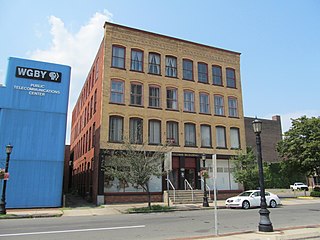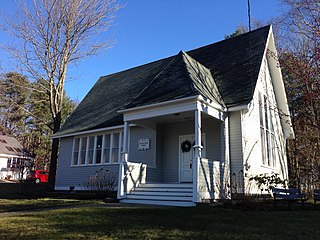
The Nathan and Mary (Polly) Johnson properties are a National Historic Landmark at 17–19 and 21 Seventh Street in New Bedford, Massachusetts. Originally the building consisted of two structures, one dating to the 1820s and an 1857 house joined with the older one shortly after construction. They have since been restored and now house the New Bedford Historical Society. The two properties are significant for their association with leading members of the abolitionist movement in Massachusetts, and as the only surviving residence in New Bedford of Frederick Douglass. Nathan and Polly Johnson were free African-Americans who are known to have sheltered escaped slaves using the Underground Railroad from 1822 on. Both were also successful in local business; Nathan as a caterer and Polly as a confectioner.

The First Free Will Baptist Church are a historic Free Will Baptist Church complex in Ashland, New Hampshire. The complex consists of three buildings: the brick church building, which was built in 1834; the old vestry, a brick building standing near the street which was built c. 1835 as a school and converted to a vestry in 1878; and the new vestry, a wooden structure added in 1899 to join the two brick buildings together. The church, a fine vernacular Federal style building when it was built, had its interior extensively restyled in the late 19th and early 20th centuries. The complex was listed on the National Register of Historic Places in 1983, primarily as a good example of modest Victorian church architecture. It now houses the Ashland Community Church.

The Whitcomb Warehouse is a historic warehouse at 32-34 Hampden Street in Springfield, Massachusetts. Built in 1896, it is one of the most intact late 19th century industrial buildings in Springfield. It was listed on the National Register of Historic Places in 1983.

The William V. N. Barlow House is on South Clinton Street in Albion, New York, United States. It is a brick building erected in the 1870s in an eclectic mix of contemporary architectural styles, including Second Empire, Italianate, and Queen Anne. Its interior features highly intricate Eastlake style woodwork.

The First Baptist Church, also known as the Old Corner Church, is a historic church at West and Federal Streets in Waterboro, Maine. Built in 1803-04 and altered to a Greek Revival appearance in 1849, it retains significant characteristics of more traditional Federal period meetinghouses. The building was listed on the National Register of Historic Places in 1988.

Cousins Island Chapel is an historic non-denominational chapel at 414 Cousins Street on Cousins Island, an island in Casco Bay off the coast of Yarmouth, Maine. Built in 1894 by local year-round residents, it is the most architecturally notable building on the island, and is representative of a late 19th-century trend of building summer chapels in coastal Maine. It was listed on the National Register of Historic Places in 1997.

The North Yarmouth and Freeport Baptist Meetinghouse, also known as the Old Baptist Meeting House, is an historic church on Hillside Street in Yarmouth, Maine. Built in 1796 and twice altered in the 19th century, it is believed to be the oldest surviving church built for a Baptist congregation in the state of Maine. It is now owned by the town and maintained by a local non-profit organization.

The Elder Grey Meetinghouse is a historic church on Chadbourne Ridge Road in North Waterboro, Maine. Built in 1806, it is one of Maine's oldest churches. The building is now maintained by a preservation association, which hosts annual services each August. The building was listed on the National Register of Historic Places in 1979.

The First Congregational Church, United Church of Christ, also known as the New Old South Congregational Church, is a historic church at 235 Main Street in Farmington, Maine. The congregation's present sanctuary is a brick Romanesque structure designed by George M. Coombs and was completed in 1887. It is the town's finest 19th-century church, and one of the most architecturally sophisticated in the region. It was listed on the National Register of Historic Places in 1974. The congregation, established in 1814, celebrated its 200th anniversary in 2014.

The Old Union Meetinghouse, now the Union Baptist Church, is a historic church at 107 Mason Road in the Farmington Falls area of Farmington, Maine. Built in 1826–27, it is a high-quality and well-preserved example of a traditional late-colonial meetinghouse with Federal-style details. The building was listed on the National Register of Historic Places in 1973.

The Bell Hill Meetinghouse is a historic church building located at 191 Bell Hill Road in Otisfield, Maine. The building was the work of local master builder Nathan Nutting Jr. (1804-1867), having since remained a significant example of transitional Federal-Greek Revival architecture. It was listed on the National Register of Historic Places in 2003 to ensure its preservation.

The Bingham Free Meetinghouse is a historic church on South Main Street in Bingham, Maine. Built in 1835–36, this wood-frame structure was the first church to be built north of Caratunk Falls in northwestern Maine. The building is architecturally transitional, exhibiting both Federal and Gothic Revival elements. It was listed on the National Register of Historic Places in 1976.

The Former First Baptist Church is a historic church building at 37 Main Street in Skowhegan, Maine. Built in 1842-44, this Greek Revival brick building is one of the few works attributable to a local master builder, Joseph Bigelow. It was used as a church until 1919, after which it was used as a community center, and then a VFW hall until 2009. It is vacant, with plans to establish a performance and meeting venue; it was listed on the National Register of Historic Places in 1991.

The Union Meetinghouse is a historic church on United States Route 7 in Ferrisburg, Vermont. Built in 1840, it is architecturally an eclectic combination of Federal period design with Gothic Revival features. It was listed on the National Register of Historic Places in 1978.

The Bell Hill School or District Number One School is an historic school in Otisfield, Maine. The one-room brick schoolhouse was one of three completed in 1839 for the town, and is the only one to survive. It served the town as a district school until 1940. It was acquired in 1950 by the Bell Hill Meetinghouse Association, and has been converted into a local history museum. The building was listed on the National Register of Historic Places in 2003.

The North Grove Street Historic District is located along the north end of that street in Tarrytown, New York, United States. It consists of five mid-19th century residences, on both sides of the street, and a carriage barn. In 1979 it was listed on the National Register of Historic Places.

Marshall House, also known as McNeil House, is a historic home located at New Cumberland, Hancock County, West Virginia. It was built in 1887 and is a 2+1⁄2-story, Queen Anne style brick dwelling. It was built by West Virginia State Senator Oliver S. Marshall (1850-1934) and remained his home until his death.

The Former Otisfield Town House is a former town hall building at 53 Bell Hill Road in Otisfield, Maine. Built in 1905 to replace a structure dating to the 1790s, it is architecturally reminiscent of mid-19th century rural Maine town halls. It was used as town hall until 1985, and as a polling place until 2002. It was listed on the National Register of Historic Places in 2005.

The Spaulding House is a historic house on Main Street in Norridgewock, Maine. Built about 1835 by one of the town's early settlers, it is a fine local example of Greek Revival executed in brick. The house was listed on the National Register of Historic Places in 1978.

The Algernon Bangs House is a historic house at 16 East Chestnut Street in Augusta, Maine. Built in 1892, it is a distinctive and idiosyncratic exhibition of Queen Anne architecture. It was listed on the National Register of Historic Places in 1982, and now houses professional offices.






















